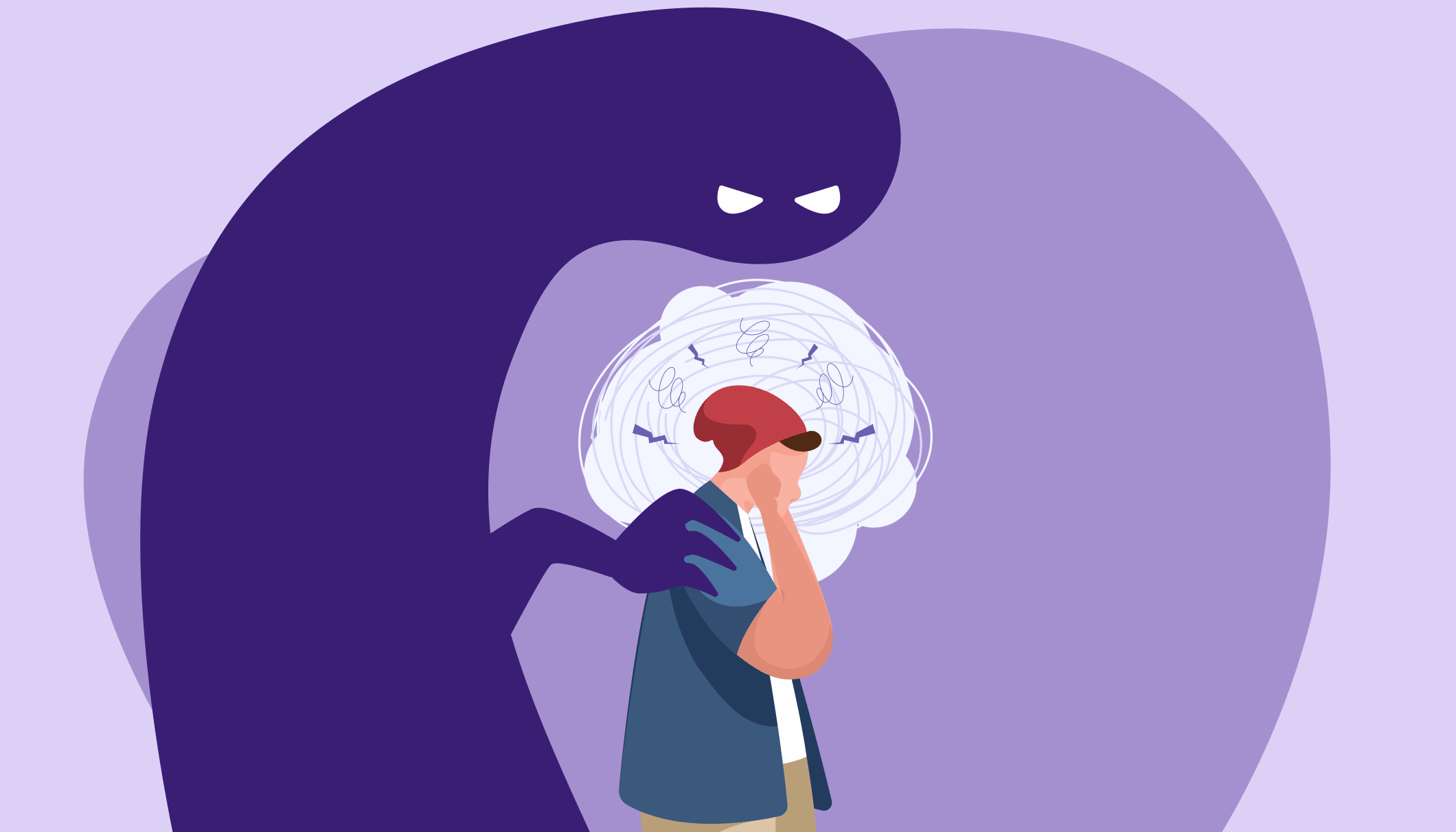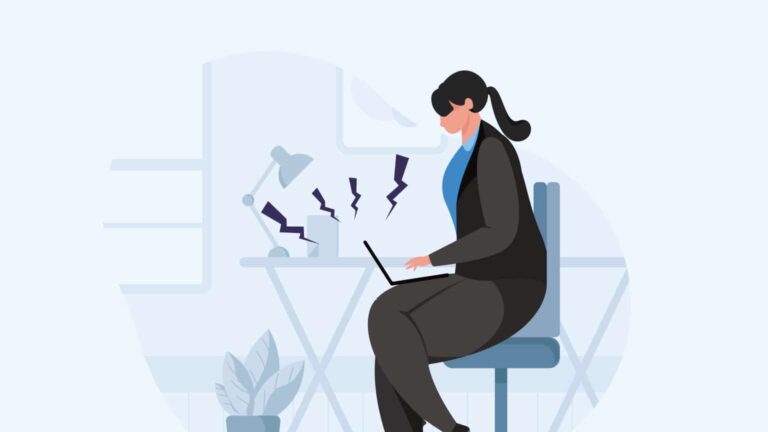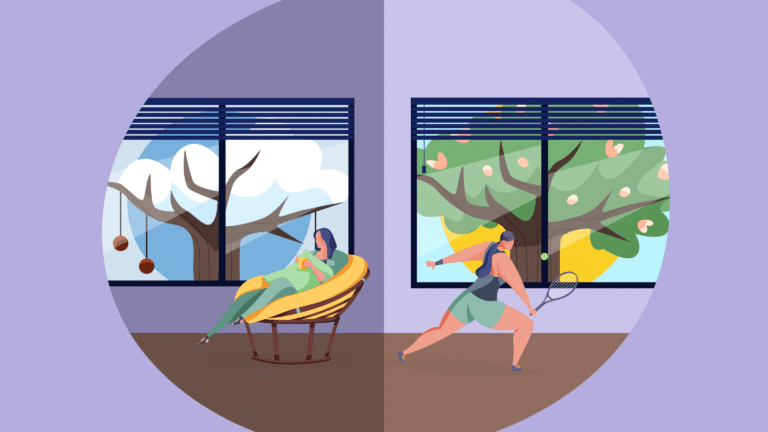In this article, you’ll learn what causes panic attacks, how to recognise the symptoms and how to prevent them early on using the correct techniques.
What causes panic attacks?
First things first: panic attacks often don’t have a specific trigger. However, they are most likely to occur when you’re anxious, have been stressed for a long time or are dealing with unresolved issues.
“Anxiety is a natural human reaction that occurs when you feel threatened,” says psychologist Emma White. “Most people feel anxious from time to time. Anxiety is only classed as a mental health problem when it impedes your ability to live your life the way you want,” says White.
A panic attack is an extreme type of anxiety reaction. You might experience one on holiday or – quite unremarkably – one evening on the sofa. Then, once you’ve had a panic attack, your fear of panic intensifies. You become afraid of experiencing this situation again. This can lead to certain problems manifesting and you avoiding particular things, meaning you aren’t able to live your life the way you want.
Your lifestyle might also contribute to panic attacks. Getting enough sleep, eating healthily and exercising are good for your body and make you more resilient against stress. You should avoid alcohol, nicotine, caffeine and other drugs, if you’re prone to panic attacks and often suffer from anxiety.
Also, genetic predisposition, personality traits, childhood experiences (e.g., overprotective parents, unmet needs) and previous experiences with illnesses – e.g., if you’ve experienced a heart attack – play a role. This means that panic attacks involve a whole cocktail of factors and it’s hard to pin it down to one thing.
💡 As is often the case, prevention is better than cure. Click here to learn how you can turn stress and fear into a good thing.
What happens to your body during a panic attack?
A panic attack feels much worse than it actually is. Most of them reach their peak after 10 minutes and are over after 30 minutes. While many people are only affected by panic attacks a few times in their lives, some people experience daily panic attacks. Although they are difficult to deal with, they aren’t actually dangerous at all. From an evolutionary perspective, panic attacks are even a good thing. They put us on high alert and warn us about dangerous situations. But how can we identify panic attacks?
A panic attack triggers a chain reaction in the body. The stress hormone adrenaline is released, causing the vessels to contract, the heartbeat to accelerate, more blood to be pumped through the veins and the muscles to tense up. As a result, you feel a tightness in your chest, which makes you feel like you can’t breathe properly. We’ve listed a few of the most common symptoms that will help you to identify a panic attack and keep your calm.
The most common symptoms of a panic attack
Due to the chain reaction in the body that we’ve already described, you’ll feel that you want to run away and maybe even feel terrified that you might be dying. However, resisting the panic attack often makes things worse. By learning to identify a panic attack, you can take the appropriate measures that will help you to overcome it. Here are the 9 most common symptoms of a panic attack:
1. Racing heart
One of the most common symptoms of a panic attack is a racing heart. The person’s pulse increases and their heart literally pounds in their chest. Some also experience palpations or an irregular heartbeat. If in doubt, you should get symptoms like this checked out by a medical professional. This way you can make sure that you’re healthy and quell any feelings of anxiety.
2. Feeling of tightness in the neck and chest
Due to intense internal pressure, the chest muscles also contract. This means that people who experience panic attacks often feel a tightness, stabbing or burning in their chest and this makes them afraid that they might be having a heart attack. As before, it’s better to seek medical attention so that you can rule this out as a cause.
3. Shortness of breath
As a result of the tightness in your chest, you might also experience difficulty breathing. People who experience panic attacks, feel like they can’t breathe properly and have shortness of breath. Hyperventilation sometimes occurs because you’re afraid that you’re suffocating. Breathing exercises can help you to manage these symptoms. By mastering a few effective techniques, you’ll also feel better able to cope with situations like these.
4. Sweating
From hot flushes and sweating to chills and shivering: panic attack symptoms vary widely.
5. Stomach ache and diarrhoea
Anxiety affects many people in the stomach. People who suffer from anxiety disorders complain of both nausea and stomach aches, as well as flatulence and diarrhoea.
6. Dizziness
Sudden eye flashes and dizziness are also some of the more common symptoms of a panic attack. People affected by this are often worried about losing control and fainting.
7. Dry mouth
So, what does a dry mouth have to do with panic attacks? There’s actually a simple answer to this question: agitation causes you to produce less saliva. What’s more, people often breathe through their mouths during panic attacks, which allows dry air to enter the throat. This means that difficulty swallowing is another symptom of a panic attack.
8. Headaches
Whether it’s a groggy feeling in the head, brain fog or intense pressure: a panic attack is often detectable in the head and gives many people headaches.
9. Tingling and numbness
Are you experiencing unpleasant tingling and numbness in the arms and legs or intense itching? You can also identify a panic attack from these symptoms because it affects the skin too.
How can you manage panic attacks?
Although a panic attack is generally over quite quickly, it often feels like it goes on forever. The good news is that you can learn to manage panic attacks by developing a few techniques and not making things worse. Don’t try to fight back when you recognise the symptoms of a panic attack; instead, accept the situation. Remind yourself that your life isn’t in danger and that this state of anxiety will pass. It’s best to stay where you are and try to concentrate on something, like a familiar object or fixed point in the room. If you have friends to support you, talk to them and make sure you’re chatting about trivial things.
Calm breathing also helps you to control your emotions. So, if you’re having a panic attack, try to concentrate on this. You can practice 4-7-8 breathing to calm yourself down again. Inhale slowly through your nose and count to 4, then hold your breath while you count to 7, and exhale firmly through your mouth while you count to 8. By focusing on the exhalation, you’ll slow down your breathing pattern, which will signal to your body that it’s time to relax.
If you’re already panicking, you’ll obviously find it difficult to launch into a breathing exercise. That means it’s worth learning this technique preventatively so it feels natural to fall back on it in an emergency. Here are 3 breathing exercises to instantly calm you down (in under 5 minutes).
What are the symptoms afterwards?
After a panic attack, people feel tired and exhausted – like they would after a tough workout. It’s a good idea to rest well afterwards. These 6 tips for helping your body recover from (too much) stress might help you here.
“It often also helps to tell somebody you trust and talk it through with them. It might be helpful to ask if anybody noticed anything going on with you before you had the panic attack and to explain how you would like to be helped,” recommends psychologist White.
If you’re not sure you recognized the symptoms correctly and you think there could be a serious problem behind it, you can always arrange an appointment with your GP. It’s also important to not avoid particular places after a panic attack. Because if you do this, it will only make your anxiety worse and this will then most likely spread to other places and areas of your life.
What can I do to tackle panic attacks long term?
Therapy can help you to deal with anxiety. In 1:1 session with psychologists, you’ll learn techniques that will help you to manage your individual panic attacks.
Don’t hesitate to bring in professional support. Because you’d go to the doctor if you had a broken arm, right?
As always, prevention is better than cure. This means that you should start tackling things when you’re first confronted with the challenge and not when the problem has grown into something huge. If you are prone to panic attacks, you can adjust your lifestyle. For example, exercise has a particularly positive effect because you’ll learn that a higher pulse can also be a normal reaction from your body. This will make you more resilient and help you to take charge of your life.
Stress management techniques, relaxation exercises and mindfulness will also pre-emptively help you to deal with stressful situations and make it easier to manage a panic attack. At OpenUp, you can practice mindfulness one-on-one or in group sessions.





